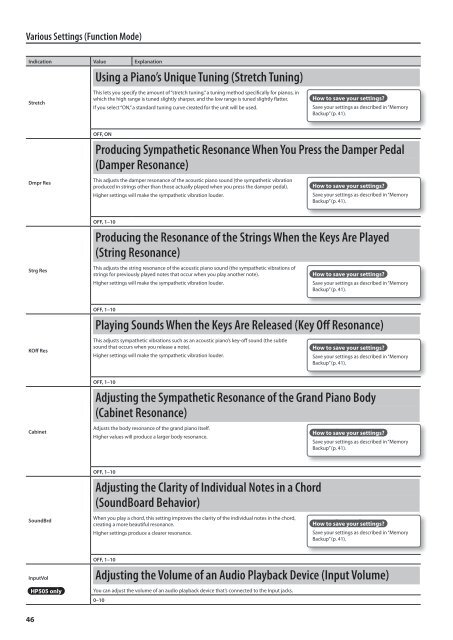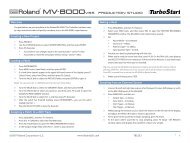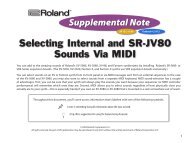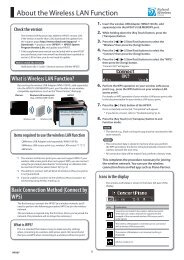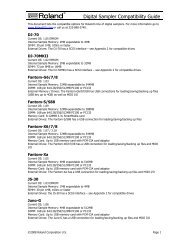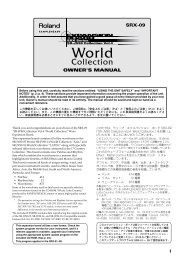HP-505/503 Manual (PDF) - Roland
HP-505/503 Manual (PDF) - Roland
HP-505/503 Manual (PDF) - Roland
You also want an ePaper? Increase the reach of your titles
YUMPU automatically turns print PDFs into web optimized ePapers that Google loves.
Various Settings (Function Mode)<br />
Indication Value Explanation<br />
Using a Piano’s Unique Tuning (Stretch Tuning)<br />
Stretch<br />
This lets you specify the amount of “stretch tuning,” a tuning method specifically for pianos, in<br />
which the high range is tuned slightly sharper, and the low range is tuned slightly flatter.<br />
If you select “ON,” a standard tuning curve created for the unit will be used.<br />
How to save your settings?<br />
Save your settings as described in “Memory<br />
Backup” (p. 41).<br />
OFF, ON<br />
Producing Sympathetic Resonance When You Press the Damper Pedal<br />
(Damper Resonance)<br />
Dmpr Res<br />
This adjusts the damper resonance of the acoustic piano sound (the sympathetic vibration<br />
produced in strings other than those actually played when you press the damper pedal).<br />
Higher settings will make the sympathetic vibration louder.<br />
How to save your settings?<br />
Save your settings as described in “Memory<br />
Backup” (p. 41).<br />
OFF, 1–10<br />
Producing the Resonance of the Strings When the Keys Are Played<br />
(String Resonance)<br />
Strg Res<br />
This adjusts the string resonance of the acoustic piano sound (the sympathetic vibrations of<br />
strings for previously played notes that occur when you play another note).<br />
Higher settings will make the sympathetic vibration louder.<br />
How to save your settings?<br />
Save your settings as described in “Memory<br />
Backup” (p. 41).<br />
OFF, 1–10<br />
Playing Sounds When the Keys Are Released (Key Off Resonance)<br />
KOff Res<br />
This adjusts sympathetic vibrations such as an acoustic piano’s key-off sound (the subtle<br />
sound that occurs when you release a note).<br />
Higher settings will make the sympathetic vibration louder.<br />
How to save your settings?<br />
Save your settings as described in “Memory<br />
Backup” (p. 41).<br />
OFF, 1–10<br />
Adjusting the Sympathetic Resonance of the Grand Piano Body<br />
(Cabinet Resonance)<br />
Cabinet<br />
Adjusts the body resonance of the grand piano itself.<br />
Higher values will produce a larger body resonance.<br />
How to save your settings?<br />
Save your settings as described in “Memory<br />
Backup” (p. 41).<br />
OFF, 1–10<br />
Adjusting the Clarity of Individual Notes in a Chord<br />
(SoundBoard Behavior)<br />
SoundBrd<br />
When you play a chord, this setting improves the clarity of the individual notes in the chord,<br />
creating a more beautiful resonance.<br />
Higher settings produce a clearer resonance.<br />
How to save your settings?<br />
Save your settings as described in “Memory<br />
Backup” (p. 41).<br />
InputVol<br />
<strong>HP</strong><strong>505</strong> only<br />
OFF, 1–10<br />
Adjusting the Volume of an Audio Playback Device (Input Volume)<br />
You can adjust the volume of an audio playback device that’s connected to the Input jacks.<br />
0–10<br />
46


